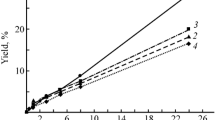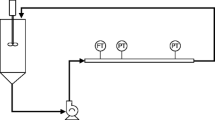Abstract
Drag reduction is the effective reduction of the fluid flow friction brought about by the addition of small amounts of dissolved polymer, suspended particles, or emulsions. This study has focused on the turbulent-flow drag reduction effected by small amounts (10-6–10-3 g/ml) of polyisobutylene dissolved in organic solvents of varying solubility parameters. The data show that a maximum drag reduction (up to 70% for Reynolds numbers of 20,000) occurs in solvents with a solubility parameter near that of the polymer.





Similar content being viewed by others
Abbreviations
- f :
-
dimensionless friction factor
- D :
-
diameter of tube
- ΔP :
-
pressure drop over length of tube
- ρ :
-
density of the fluid
- L :
-
length of tube
- V :
-
velocity of fluid through the tube
- µ :
-
viscosity of fluid
- Re:
-
dimensionless Reynolds number (DVρ/μ)
- δ :
-
polymer solubility parameter (CED)1/2
- CED:
-
cohesive energy density
References
Bird RB et al. (1960) Transport Phenomena. Wiley, New York, pp 187
Burger ED (1982) Flow Increase in the Trans Alaska Pipeline Through Use of a Polymer Drag-Reducing Additive. J Pet Tech 34:377
Horn AF, et al. (1986) High Viscosity Crude Drag Reduction. Pipeline and Gas. J 213:22
Lumley JL (1969) Drag Reduction by Additives. Ann Rev Fluid Mech 1:367
Rodriguez F (1996) Principles of Polymer Systems. Taylor & Francis, London, pp 33
Shakhovskaya LI, et al. (1980) The Relationship Between the Molecular Characteristics of Poly(Methyl Methacrylate) and the Toms Effect. Poly Sci USSR 22:1090–1096
Texaco Chemical Company (1991) Solvents Data. Texaco Chemical Company, San Ramon, Ca, USA
Tiu C, Chee NO (1977) Turbulent Flow Behavior of Dilute Polymer Solutions in an Annulus. Can J Chem Eng 57:572–577
Tobolsky A (1961) Properties and Stuctures of Polymers. Wiley, Chichester, pp 64
Toms BA (1948) Some Observations of the Flow of Linear Polymer Solutions Through Straight Tubes at Large Reynolds Numbers. In: Proceedings of the International Congress on Rheology 135, 1948
Virk PS, et al. (1967) The Toms Phenomenon: Turbulent Pipe Flow of Dilute Polymer Solutions. J Fluid Mech 30:305–328
Author information
Authors and Affiliations
Rights and permissions
About this article
Cite this article
Martin, J.R., Shapella, B.D. The effect of solvent solubility parameter on turbulent flow drag reduction in polyisobutylene solutions. Exp Fluids 34, 535–539 (2003). https://doi.org/10.1007/s00348-002-0564-y
Received:
Accepted:
Published:
Issue Date:
DOI: https://doi.org/10.1007/s00348-002-0564-y




